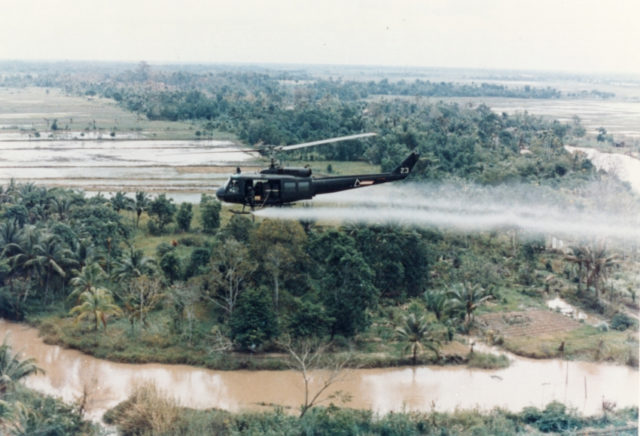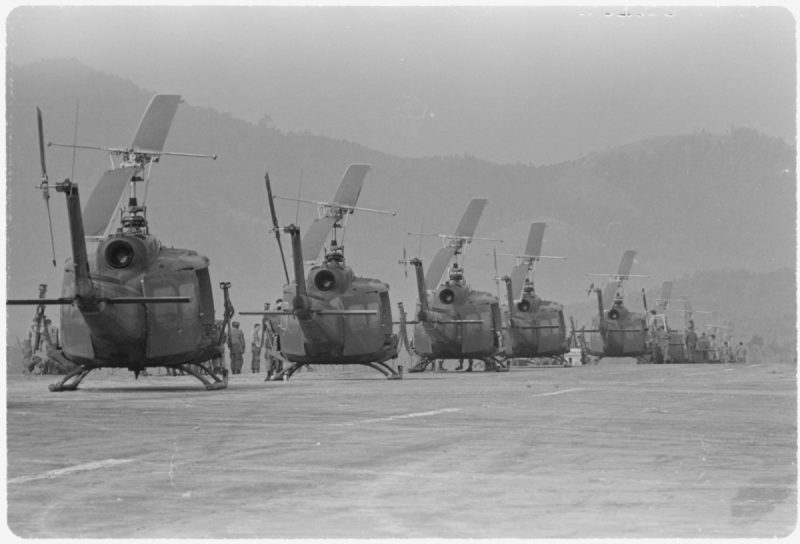Between 1961 and 1975, thousands of U.S. military helicopter pilots, gunners, crew chiefs, and medics spearheaded U.S. attempts to hold the 67,000 square miles of South Vietnam. They were defeated by the North Vietnamese and now, 50 years later, they are fighting one more battle. This time, their ranks thinned by time, they are fighting for a smaller piece of territory: a piece of land only five square feet in Arlington National Cemetery. This time, the enemy is the U.S. Army, and they are winning.
Vietnam has long been titled the “Helicopter War.” The characteristic sound of UH-1 Huey choppers is burned into the memories of Vietnam veterans. Vietnam was where the Army inaugurated its concept of “air mobility” — skies flowing with helicopters hustling troops to the front, taking them from trouble, retrieving the wounded, and bringing home the dead.
Approximately 12,000 U.S. military helicopters accumulated 7.5 million hours above Vietnam, logging 2 million missions. The aerial units were the only combat unit of the U.S. Army that did not disintegrate under the wartime stress in Vietnam; Neal Sheehan penned in A Bright Shining Lie, his 1988 Pulitzer Prize-winning classic about the conflict.
In total, 5,086 choppers, about 42%, were eliminated by enemy fire, mechanical snafus, and bad weather. The death toll was 2,002 pilots killed and 2,704 crew chiefs and gunners, about 7% of the 58,000 American troops who died in Vietnam. More than 90,000 wounded—more than half of them American— and countless others were saved.
Steve Bird says as a combat medic, he can supply a long list of servicemen who are alive now because of medevacs. He spent 1968 with the 1st Air Cavalry Division. That July, he witnessed the heroism of the helicopter crews close to the Ho Chi Minh trail when his company of 110 soldiers clashed with a North Vietnamese regiment of approximately 700 troops. American forces spent 48 hours held down as rescue choppers made repeated efforts to assist them during the enemy fire before eventually getting them out.

Fourteen U.S. soldiers were killed, and six others wounded, including Bird, who was shot in his left shoulder. In all the confusion of that war, his mission was clean, pure, and simple—rescue the wounded, said Art Jacobs, who was wounded on board his Huey while trying to rescue Bird and his buddies on his third attempt. Four months later, Bird was rescued by helicopter again after a second wounding. He can’t express his gratitude in words, he said, to say what those guys did for them.
The 15,000-member Vietnam Helicopters Pilots Association (VHPA) believes the bravery of their comrades killed in that conflict (10% of whom are buried at Arlington) deserved recognition in a burial at Arlington. VHPA began lobbying for a memorial in 2016. It pledged to the Army it would pay the $6,000 cost, as well as establishing a trust fund to sustain it in the future.
Bob Hesselbein, 64, who logged 681 hours flying AH-1 Cobra gunships over Vietnam in 1972 and VHPA’s former president, has spearheaded the fight for what he terms a small and humble memorial to his lost brothers. Their planned 4-by-3-foot Barre granite monument would be atop a 5-foot base. In 2014, the pilots’ group (later to amalgamate with the Vietnam Helicopter Crew Members Association, made up largely of the gunner and crew chiefs who kept the war birds airborne and protected in flight) formally sought Arlington’s approval, Time reported.
However, the Army’s Advisory Committee on Arlington National Cemetery in a tie 3-to-3 vote deadlocked on the proposal (a seventh member was missing when the vote was taken) in March 2015. Three Vietnam vets on the panel split: Max Cleland, a former Georgia senator and Veterans Administrating head who sacrificed three limbs in Vietnam, and Thomas Kelley, a Medal of Honour recipient for gallantry, supported the monument. James Peake, who earned a Silver Star in Vietnam before becoming an Army physician and leading the Department of Veterans Affairs for two years from 2007 to 2009, and two other members opposed it, saying Arlington should be prevented from becoming a monument park.
The panel’s stalemate stopped at the desk of John McHugh, then the Army secretary, who, following 18 years in the House (including 16 years with the armed services committee, and 14 co-chairing the House Army Caucus) came to the Pentagon. In July 2015, he told Cleland (the advisory panel’s chairman) that he did not approve the appeal for the Vietnam Helicopter monument.
Hesselbein and other pilots seem resigned to accept whatever commemoration they get. “Vietnam was something of an embarrassment to the grand military history of the United States,” he said. “They’re just hoping we all pass away.”
